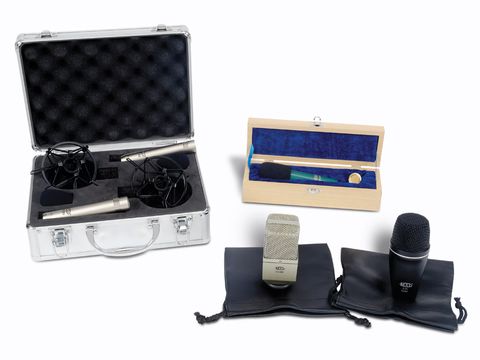MXL microphones are manufactured by American technology giant Marshall Electronics (not to be confused with the legendary British guitar amps). Well known around the rest of the world, MXL mics are now being distributed in the UK by Bedfordshire-based pro recording specialist musictrack.
For review, musictrack sent a selection of four mid-range models, all of which are suitable for miking drums. Mark Gordon of musictrack describes the mics as being robust enough to cope with live situations yet providing a quality of sound that would stand up in a studio.
"The mics gave our kit a warm, natural and clear sound, so the drums had a polished presence front-of-house."
The four mics are the A-55 Kicker, which lends itself to bass drums and other low-end instruments, the chunky-looking multipurpose Cube, a pair of 603 overhead mics and a V67n small diaphragm condenser mic.
Of the four, only the A-55 Kicker is a dynamic mic, with the other three models all being condenser models. With its large diameter, black metal casing and protective front mesh, the A-55 Kicker looks ready to spend its working life in close proximity to a bass drum. A second glance at its name reveals a barely coded reference to its claimed butt-shaking capabilities.
Part resembling a vintage vocal mic is the Cube. Its square-sided housing conceals a condenser element with a gold-sputtered diaphragm. Sputtering is a process that applies an incredibly thin layer - in this case 6/1000th of a millimetre - of gold to the surface of the diaphragm. This makes the diaphragm rigid while leaving it capable of agile movement, so making the mic sensitive and efficient. MXL recommends the Cube for all types of percussive miking duties.
The pair of 603 condenser mics have been designed to be used as joint overheads above a kit, but MXL claims that they can also be used for miking vocals, strings, piano and even guitar amps.
The green and gold V67n is described as being similarly versatile and able to record a variety of different instruments. Both the V67n and the pair of 603s also feature a 6-micron gold-sputtered diaphragm.
Unlike the 603s, the V67n contains a transformer, which, Mark Gordon explains, imbues it with subtly different tonal characteristics.
Hands On
We tested the mics at a gig. The bass and snare drum were close-miked with the A55-Kicker and the Cube respectively, while the pair of 603s covered the rest of the kit using the overhead miking method pioneered by Glyn Johns (one mic overhead aimed down at the snare, with the other at 90° from the side, pointing over the top of the floor tom towards the hi-hat).
The venue was a large marquee - a tricky environment for sound reinforcement that made an ideal test.
The A55-Kicker got things off to a good start, supplying a strong signal with little required in the way of EQ. Plenty of bottom-end was present and the sound was fairly clean and consequently it sat distinctly in the mix.
A few mic placings were required with the Cube to get an optimal result but, once settled on, the snare sounded excellent. What was most impressive was the way it reproduced the whole of the drum's sound.
When miking, that's not always straightforward to do, as the process can unintentionally promote elements of a snare's sound over others. Here, the metallic crack was present, as was the crispness of the wires along with the warmth of the shell - the whole package.
Swapping the Cube for the V67n brought a little more middle and top end to the sound and a greater degree of sensitivity. This suggested that the V67n is geared to perform in quieter musical scenarios - someone who plays predominantly with brushes perhaps - and would also be well suited to the controlled environment of a studio.
The 603s had major frequency contrasts to cover (a rack tom, a floor tom, a pair of hi-hats and three cymbals) but did so outstandingly. The cymbals came through brightly, but were sweet and full-bodied rather than overly toppy. Both toms, meanwhile, possessed a decent slap on impact that was further embellished with a resonant, airy note.
It's easy to understand why MXL has such a good reputation. Live, with only two of the drums close-miked, the mics gave our kit a warm, natural and clear sound, so our drums had a polished presence, front-of-house.
Brief tests in the studio confirmed that they are versatile enough to be seriously considered for recording too.
- Capture the perfect take with the best drum mic kits

